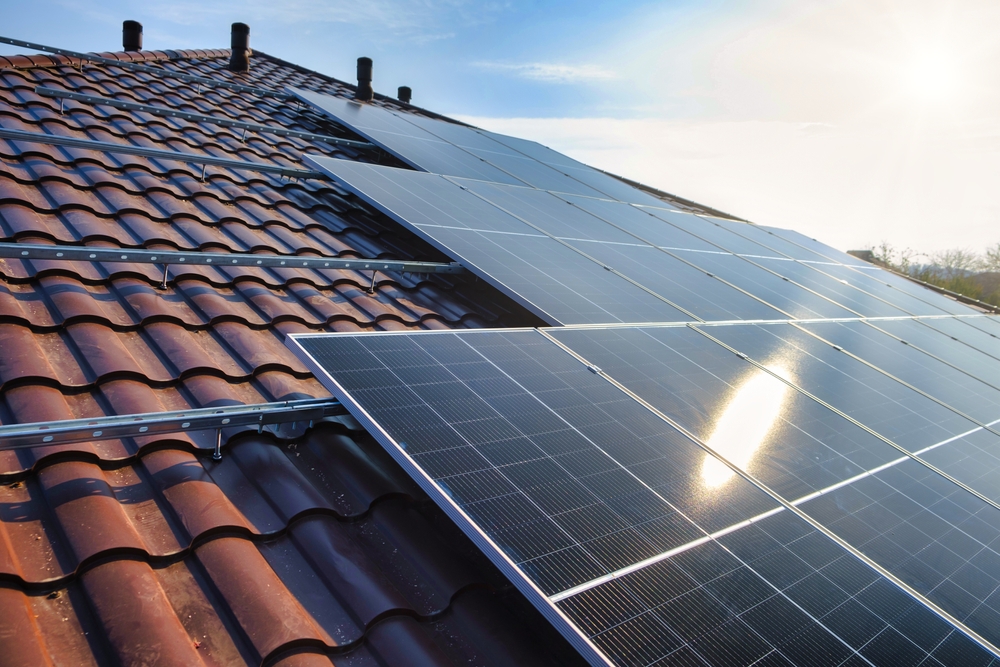Updated 1 month ago
High-Efficiency Solar Panels: Top Brands in 2025
Written by Jamie Smith Jamie SmithJamie is a Content Writer and researcher at SolarReviews. A recent graduate of La Salle University in Philadelphia, Jamie earned her B.S. in communica...Learn more , Edited by Catherine Lane Catherine LaneCatherine has been researching and reporting on the solar industry for five years and is the Written Content Manager at SolarReviews. She leads a dyna...Learn more

Why you can trust SolarReviews
SolarReviews is the leading American website for solar panel reviews and solar panel installation companies. Our industry experts have a combined three decades of solar experience and maintain editorial independence for their reviews. No company can pay to alter the reviews or review scores shown on our site. Learn more about SolarReviews and how we make money.
Key takeaways
Most home solar panels are between 21% and 22% efficient, but many manufacturers are achieving efficiencies of 23% and higher.
The most efficient residential solar panels come from Maxeon, with a 24% efficiency rating.
Other high-efficiency solar panels on the market come from JA Solar, REC Group, VSUN, and Canadian Solar.
The efficiency of solar panels is impacted by the type of solar cells used, the direction and angle that the panels are installed, and local climate and weather conditions.
Solar panel efficiency is important – but temperature coefficient, warranty coverage, power output, pricing, and manufacturer reputation are all equally important things to look into.
Solar technology is constantly evolving, with solar panels becoming cheaper and more efficient than ever.
Solar panel efficiency refers to how well solar panels can turn sunlight into usable electricity. Basically, the more efficient solar panels are, the more power they can generate. In 2025, its standard for residential solar panels to be between 21% and 22% efficient – but many brands are reaching ratings in the 23% range.
Here are the most efficient solar panels that are currently available in 2025:
Maxeon - 24%
JA Solar - 23%
REC Group - 22.6%
VSUN - 22.52%
Canadian Solar - 22.5%
Highest efficiency solar panels in 2025
Solar panel brand | Module | Efficiency rating | Power output |
|---|---|---|---|
SPR-MAX7-475 | 24.0% | 475 W | |
JAM54D40-460/LB | 23.0% | 460 W | |
REC Alpha Pure-RX 470 | 22.6% | 470 W | |
VSUN450N-96BMHR-DG-BB | 22.52% | 450 W | |
TOPHiKu6 BoB | 22.5% | 460 W |
Is solar panel efficiency important?
The efficiency of solar panels is an important thing to consider when researching solar panels – but it’s nothing to stress over. You don’t need to buy the most efficient solar panels on the market to meet your energy needs or have a good-quality installation. As long as the solar panels you use are above 20% efficient, they will produce great results for your home.
We recommend looking beyond solar panel efficiency to find the best solar panels for your home. Consider the power output, temperature coefficient, warranty coverage, pricing, and the manufacturer’s reputation.
5 most efficient solar panels
Solar panels are more efficient than ever, but some stand out about the rest. Here are the five highest efficiency solar panels for homes.
1. Maxeon: 24%

Maxeon offers the highest efficiency solar panels on the residential market. The brand has used the same solar technology since 2005, keeping it a top maker of high-quality, high-efficiency solar panels for years.
Maxeon’s latest panel in the MAX 7 collection features a 24.1% efficient panel, making it the market’s most efficient home solar panel.
Maxeon manufactured solar panels that were used by SunPower-certified dealers. Despite SunPower’s recent bankruptcy, Maxeon is still cranking out some of the best panels in the industry.
2. JA Solar: 23%
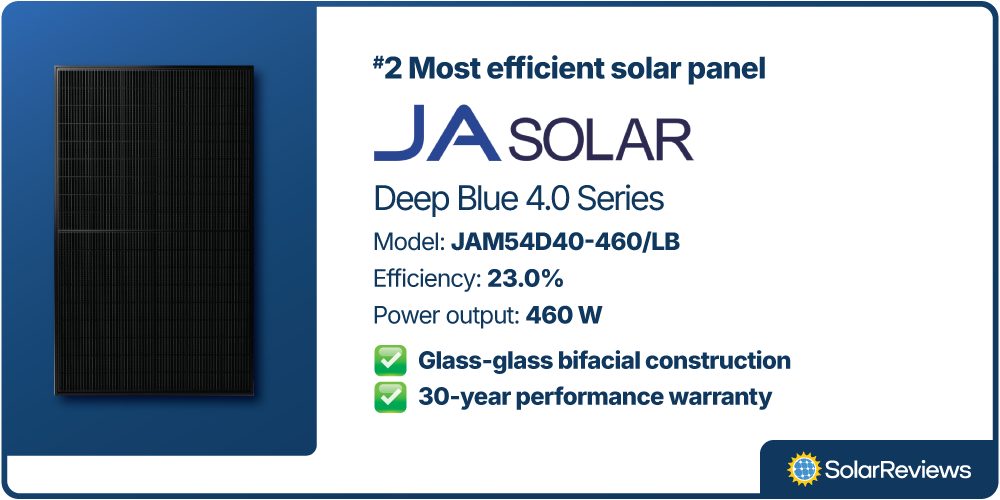
JA Solar is an affordable solar panel brand that still manages to make excellent, high-quality products. This n-type bifacial solar module is 23% efficient, landing it at #2 on our list.
This premium solar panel utilizes multi-busbar (MBB) half-cell technology. More busbars on the cell’s surface enhance panel performance and increase efficiency ratings.
JA Solar is also featured on our Best Solar Panels of 2025 list because it offers more than just high efficiency — it’s also a highly reputable brand that installers across the country trust.
3. REC Group: 22.6%
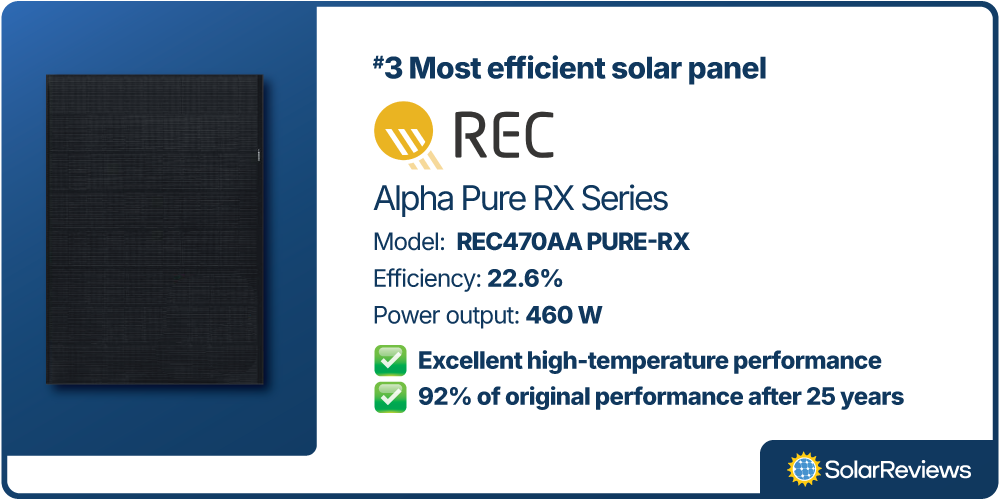
REC Group consistently puts out some of the best solar panels in the industry, unveiling high-performing modules year after year. In its latest line of Alpha Pure modules, the RX 470-watt panel clocks in at 22.6% conversion efficiency.
The solar cells within these modules are crafted with heterojunction (HJT) technology, which combines standard PV cells and thin-film technology into one, using three layers of sunlight-absorbing materials.
4. VSUN: 22.52%
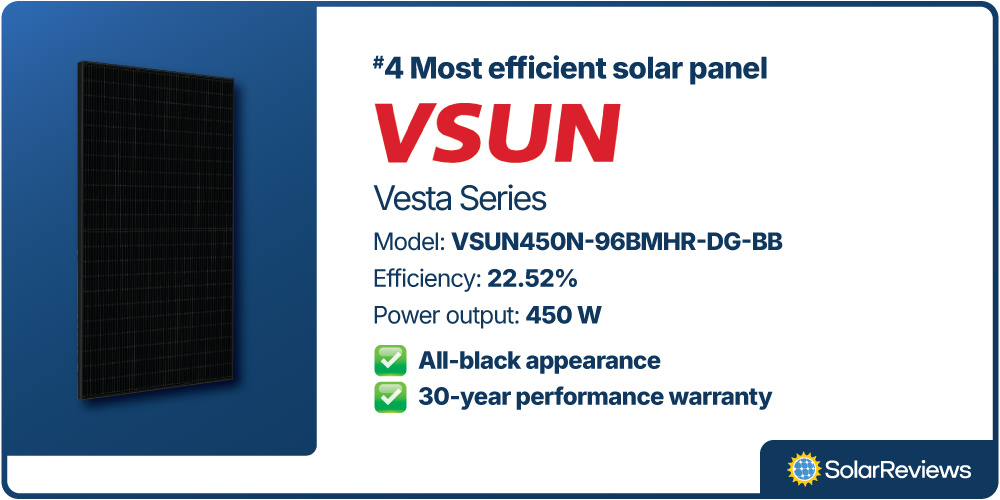
VSUN, also known as Vietnam Sunergy, is a bit of a smaller name in the world of solar power that was recently acquired as part of a merger with other solar companies under Toyo Co, ltd., still manufacturing panels under its VSUN name.
This Vietnam-based company produces high-performance panels that come at a great value. This 450-watt module has a 22.52%, just narrowly beating Canadian Solar for the fourth spot on this list.
VSUN modules utilize TOPCon technology, which uses a thin oxide layer on the panels to boost efficiency.
5. Canadian Solar: 22.5%
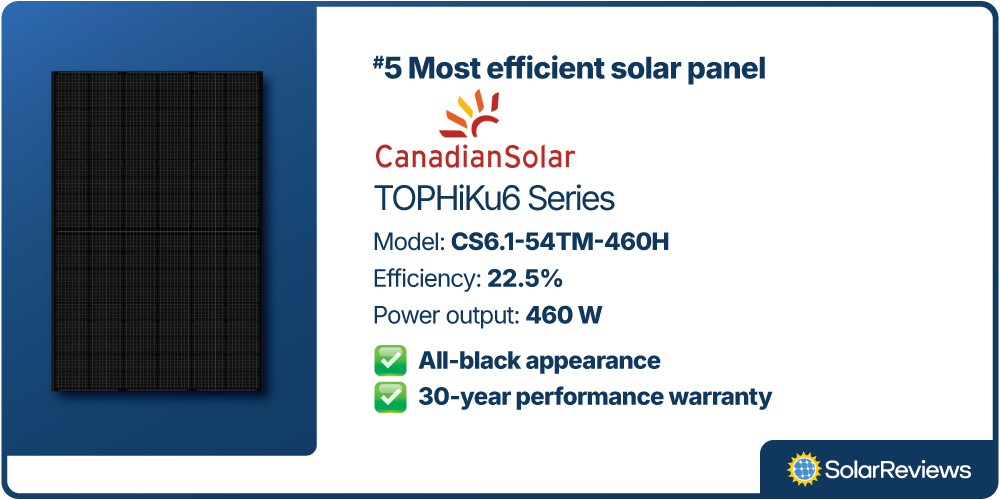
Canadian Solar is one of the biggest manufacturers in the business, offering premium quality solar energy products while still being affordable, which is why they’re our number one choice for home solar panels in 2025.
For residential solar panels, Canadian Solar offers a 460-watt panel that is 22.5% efficient. Like other panels featured on this list, Canadian Solar also uses TOPCon solar cell technology to allow for higher efficiency ratings within their panels.
What is solar panel efficiency?
Solar panel efficiency is the percentage of the sun’s energy that hits a solar panel that is converted into electricity for your home. Today, most solar home panels have efficiency ratings between 21% and 22%, with some brands reaching 23% or higher.
To put it into perspective, news broke in 2014 that solar manufacturer, First Solar, had set the world record for the most efficient PV solar cell at 20.4%. Just over ten years ago, record-breaking efficiency levels now fall within the industry standard thanks to new and evolving solar technology.
4 factors that impact solar panel efficiency
There’s a few factors that could affect how efficient your panels are and how much energy your solar panels produce, such as:
The type of solar panel
Type of solar cell technology
The angle and direction of your panels
Climate and weather conditions
Type of solar panel
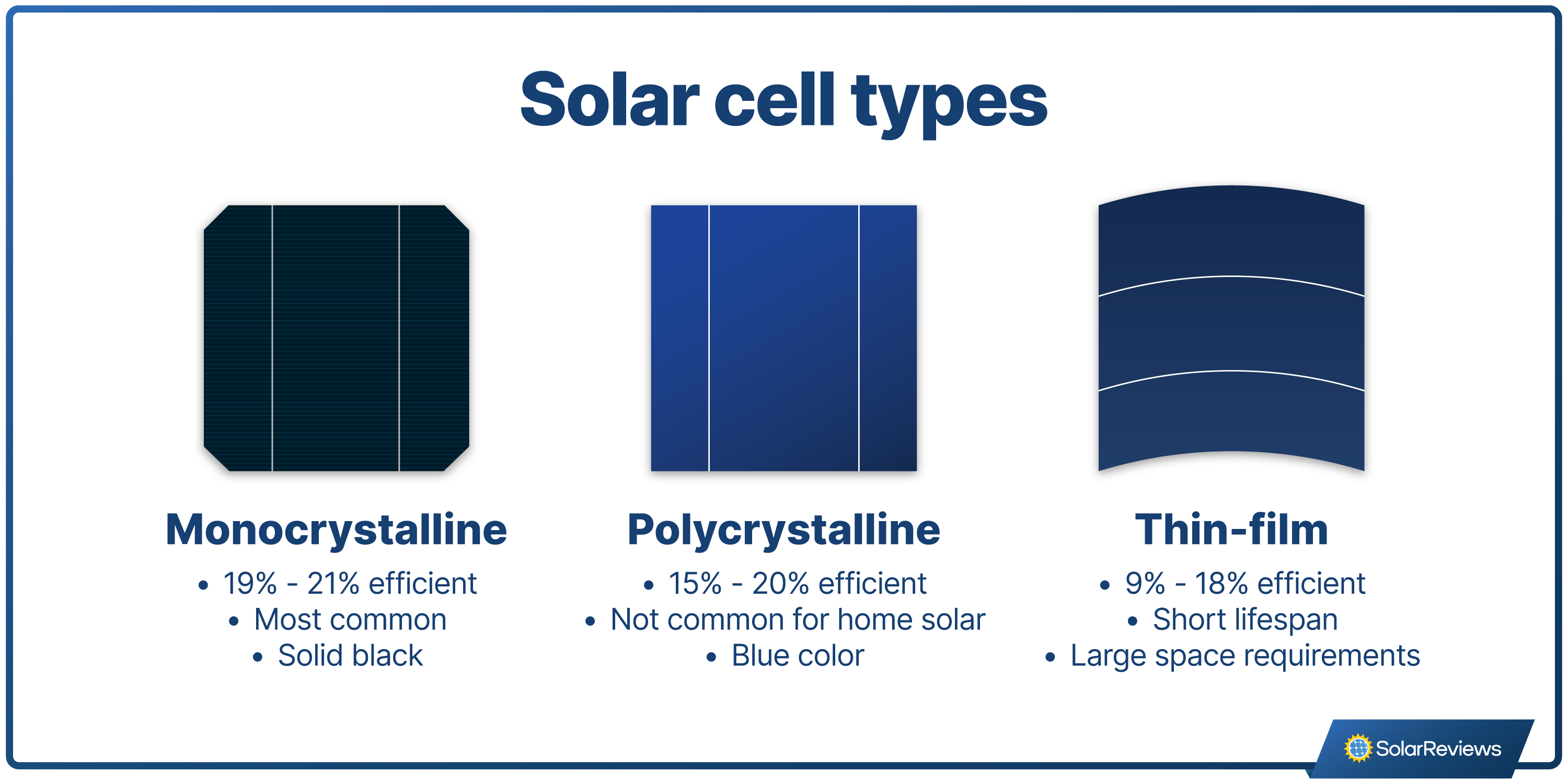
There are three main types of solar panels: monocrystalline, polycrystalline, and thin-film. These panels differ by the way they are made, and how they’re used.
Almost every home solar installation uses monocrystalline panels, because they are the most efficient. Despite being slightly more expensive than polycrystalline panels, the increased savings you get from higher-performing monocrystalline panels makes the extra cost worth it.Solar panel direction and angle
Type of solar cell technology
Monocrystalline silicon solar cells can be manufactured in different ways, which can help boost cell efficiency ratings.
Some of the most popular silicon cell technologies used among manufacturers include:
Passivated Emitter & Rear Contact (PERC) solar cells: PERC cells have an additional layer on the back of the solar cell to reflect photons that pass back into the cell, generating more electricity.
Tunnel Oxide Passivated Contact (TOPCon) solar cells: These cells are similar to PERC, but contain a thin layer of silicon dioxide and a layer of polycrystalline silicon mixed with phosphorus.
Heterojunction (HJT) technology: These cells have layers of monocrystalline and thin-film materials together in one cell to capture more light wavelengths.
Bifacial solar cells: Bifacial cells can generate more electricity from light that hits panels from the front and back, increasing efficiency.
What are perovskite solar cells?
Perovskite solar cells are a promising new technology that has not yet been introduced into the mainstream due to its high price. This type of cell technology is made with specific crystal structures that exhibit a photovoltaic effect, which could potentially reach an efficiency of 38%! However, it is not yet used in residential solar and catered more to utility-scale projects.
Solar panel direction and angle
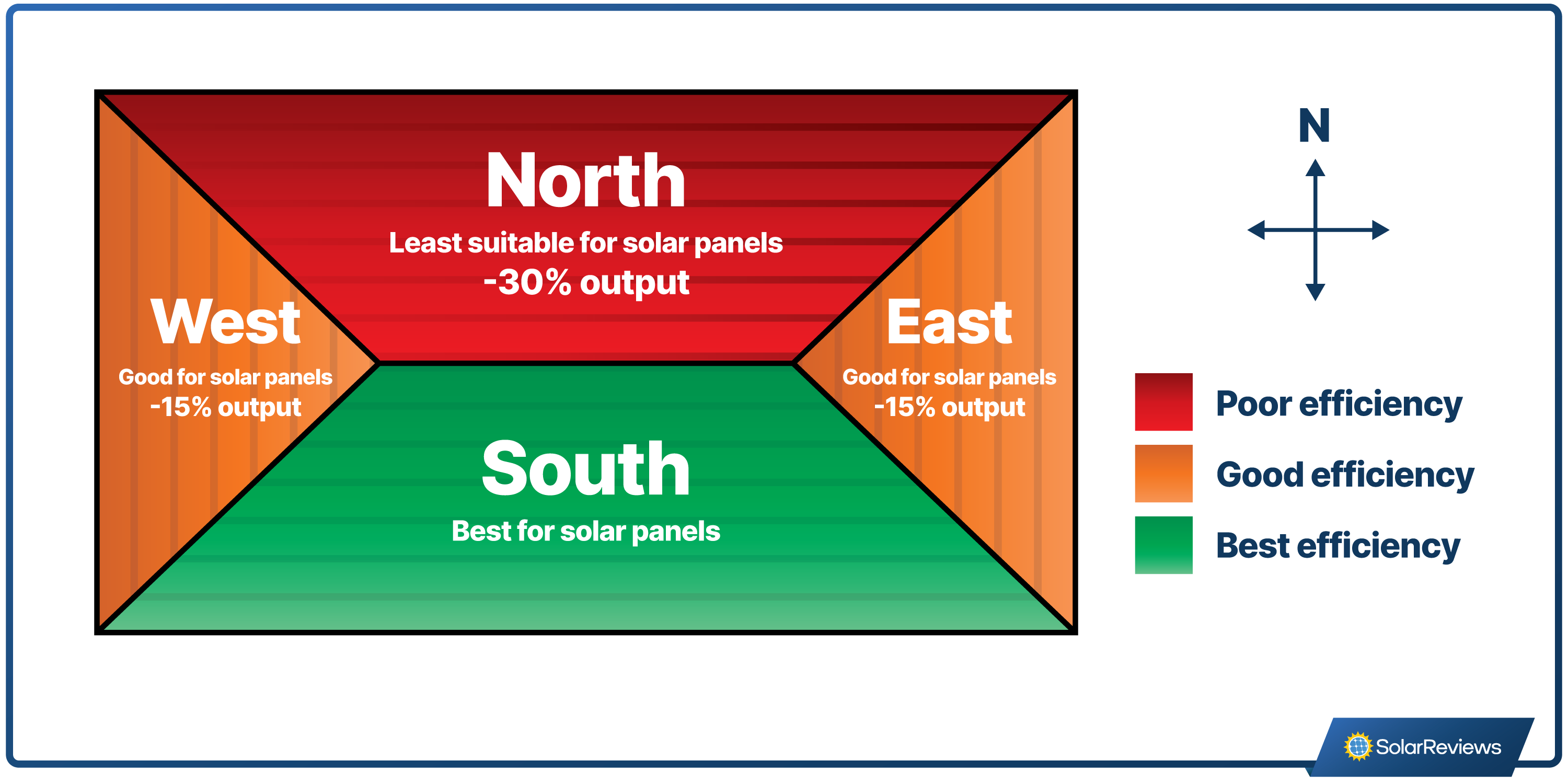
In the U.S., solar panels generate the most electricity on south-facing roofs because the sun spends most of its time in the southern sky. Solar panels installed facing west or east will still generate electricity, but they will be less efficient than those facing the south.
The angle at which solar panels are installed will also affect the efficiency of your solar system. The ideal solar panel angle is based on the latitude of your home, so it varies by location. Solar panels are generally installed anywhere between a 20 and 45-degree angle for optimal solar energy generation.
Weather and climate conditions
Solar panel efficiency is determined by standard test conditions (STC). So, real-world factors could impact how efficiently your solar panels produce energy.
For example, solar panels that are covered in snow or completely blocked by shade will produce less energy. Your solar installer will consider local weather conditions and any roof shading into account when they design your system – so you’ll get the best value for your installation!
Solar panels still work in cloudy conditions. In cloudy, overcast, or shady conditions, your solar panels are still producing energy – just less efficiently than in sunny areas that are free of shade. So, if you live in an area that experiences cloudy weather often, that shouldn’t discourage you from installing solar.
How to increase your solar system’s efficiency
There are three steps you can take to keep your panels operating at their best:
Monitor your system’s performance: With solar monitoring software, you or your installer can keep tabs on your solar system’s performance. When an issue arises, you can address it right away!
Install panels on optimal roof space: Not everyone likes the look of solar panels. In fact, some homeowners opt to install them on the back of their house – but there might be better directions for solar panels than the back of your roof! If you want the most efficient system possible, ensure you get them where they’ll get maximum sun.
Keep them clean: Solar panels covered with dust or debris can’t generate electricity effectively. Make sure your solar panels are clear, and consider professional solar panel maintenance every year if your roof accumulates significant amounts of debris.
Your solar panels won’t operate at 100%! If your panels aren’t generating the same amount of electricity today as they were the day before, that’s okay! Solar panels don’t always yield the same amount of electricity, which is considered when the system is designed. You’ll know if there’s an issue if the entire system or sections of panels are offline or if you experience low output over an extended period
High-efficiency solar panels: 4 things to consider
Efficiency ratings aren’t the only thing to consider when shopping for solar panels. Here are four things to keep in mind when finding the right panels for your home:
Cost: One of the most important things to consider when looking for high-efficiency solar panels is the price. High-efficiency solar panels tend to come with a higher price tag and add thousands or more to the total cost of your system. Thankfully, affordable solar panel brands like Canadian Solar or LONGi still offer high-efficiency solar panels that won’t cost an arm and a leg.
Warranties: Another thing to consider is the warrantied lifespan of your solar panels. Most panels today have a performance warranty of 25 years and a product warranty of 12 to 25 years.
The type of solar system: The right panels for you might also depend on what type of solar panel system you’re installing. For example, an off-grid solar system might require you to spend a little more for premium efficiency to get the maximum amount of power possible.
A reliable manufacturer: Our solar experts also recommend homeowners get panels from a reliable manufacturer. Solar panels are a decades-long investment. Although solar panel failure is extremely rare, make sure you get panels from a manufacturer that has longevity in the industry. Also, consider getting third-party warranty coverage, like Solar Insure, for your peace of mind.
Solar panel efficiency FAQ
Can solar panels be 100% efficient?
No, solar panels currently do not have the technology to make them 100% efficient – and that’s okay! Most things don’t operate as close to 100% as you think. According to research from Penn State University, automobile engines operate at 25% efficiency, and power plants are 36% efficient.
What type of solar panels are the most efficient?
Monocrystalline solar panels are the most efficient. Manufacturers can increase the efficiency of solar PV modules by using different solar cell technology, like PERC or half-cut solar cells.
Are high-efficiency solar panels more expensive?
Some premium high-efficiency solar panel brands, like Maxeon, are more expensive than other common solar manufacturers. However, there are affordable solar panels that offer high-efficiency options. For example, JA Solar has panels with 23% efficiency ratings, but their installation costs average $2.80 per watt.
Are high-efficiency solar panels worth it?
High-efficiency solar panels are worth it for most residential solar installations. That being said, having the highest-efficiency solar panel on your roof isn’t necessary for a good-quality installation.
It's better to look at what solar panels are being used as a whole and not just its efficiency. Luckily, experts at SolarReviews have compiled a list of the top solar panel brands to help you make an informed decision!
Jamie is a Content Writer and researcher at SolarReviews. A recent graduate of La Salle University in Philadelphia, Jamie earned her B.S. in communications with a concentration in journalism, mass media, and public relations. Jamie has previously worked at a marketing company where she had the opportunity to highlight and promote small business owners through long-form stories and interviews. With a deep-rooted passion for creativity, Jamie stri...
Learn more about Jamie Smith